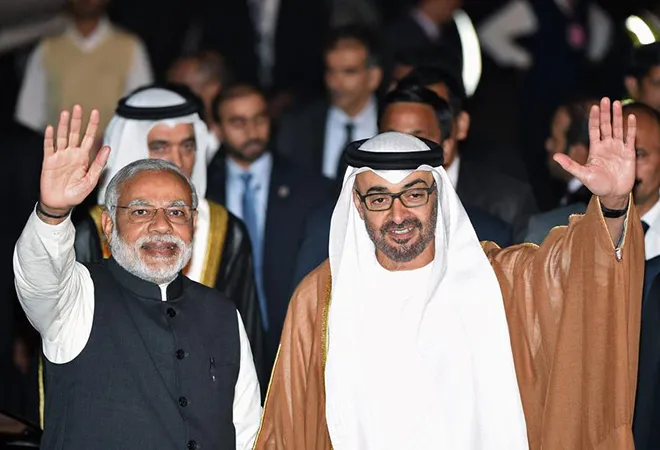
It may be seen as an anomaly that a government led by a Hindu-nationalist party, the Bharatiya Janata Party (BJP), would do well in its West Asia policy. Indeed, during Prime Minister Narendra Modi’s first term, New Delhi’s outreach to West Asia—with its multidimensional challenges, from security to religion—has arguably been one of the government’s biggest successes in foreign policymaking.
India maintained a ‘non-aligned’ presence in West Asia, balancing between the three poles of power—i.e. Israel, Iran and Saudi Arabia. At the same time, Modi’s outreach to strengthen these pre-existing but limited engagements has garnered immediate benefits, both in the security and economic arenas. Modi visited the capitals of all three power centres of Jews, Shia Muslims and Sunni Muslims alike, and his government reaped: terror suspects were deported from Saudi Arabia and the UAE; technological and defence partnerships were negotiated with Israel; and the Indian government came to the defence of India–Iran oil trade and the Chabahar investments amidst American pressure against Tehran.
<1> While these three sub-regions have gained the most, other regional players such as Turkey, Oman, Qatar, Jordan—and even Syria and Palestine—also benefitted from the Modi government’s expansion of its regional outreach.
To be sure, the optics tended to score higher than the actual deliverables in many cases. Still, these engagements have managed to create a strong bedrock for greater cooperation specifically between India and the Gulf, long seen as a difficult relationship that largely revolves around the issues of oil and Indian migrant workers. There were many firsts during Modi’s tenure, including the first staging visit by an Indian Air Force flying contingent stopping over in Saudi Arabia, and Modi getting the highest civilian honour from the UAE, the Zayed Medal.
<2> Over the past five years Modi visited all regional strongholds and areas of Indian interest: Riyadh, Tel Aviv, Abu Dhabi, Tehran and even Ramallah. In return, New Delhi hosted leaders Benjamin Netanyahu of Israel,
<3> Hassan Rouhani of Iran,
<4> Sheikh Mohammed bin Zayed of the UAE who was the chief guest at the Republic Day Parade in 2017, Saudi heir apparent Mohammed Bin Salman,
<5> and Palestine’s leader Mahmoud Abbas.
<6> These visits cut across regional tensions and conflicts to maintain not only working, but fast developing bilateral ties.
INDIA–IRAN
India shares civilisational ties with Iran. Their contemporary relations, however, have been especially relevant in India’s energy security. This is reflected in the trade between the two countries, where the balance tilts for Iran through its oil sales to India. Between 2014 and 2018, the two countries signed a total of 21
Memorandums of Understanding (MoUs), many relating to the development of Chabahar. Total trade for the years 2017–18 was recorded at US$13.8 billion; of the total, India’s imports were worth US$11.11 billion, mostly oil, while India’s exports stood at a mere US$2.7 billion (See Figure 15). This trade deficit has acted as an irritant in the bilateral for a long time. During the same period, nine high-level bilateral visits took place between Tehran and Delhi, including Modi’s visit in May 2016. This was followed by the operationalisation of the Chabahar port in January 2019, which many analysts regard as a significant economic and diplomatic feat. India has had to manage American expectations on Iran over its nuclear programme. Meanwhile, the Trump administration— after its withdrawal from the Iran Nuclear Deal,
<7>,
<8> an agreement New Delhi prodded Tehran to commit to—has escalated its moves against countries that continue to maintain bilateral relations with Iran.
Figure 15: India–Iran Bilateral Trade
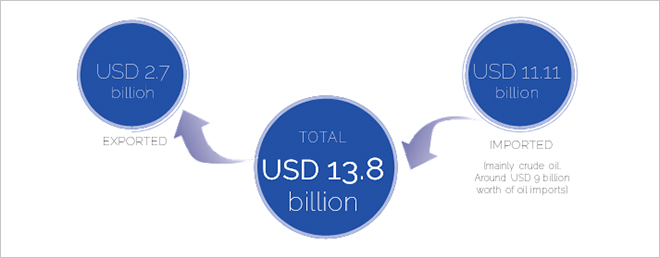 Source: Ministry of External Affairs
Source: Ministry of External Affairs
INDIA–SAUDI ARABIA
Saudi Arabia hosts more than 2.7 million Indian citizens; the sheer size of this diaspora makes it a massive responsibility for Indian diplomacy. Overall, the Indian diasporic communities across the world sent the largest amount of remittances ever recorded into India, totalling US$78 billion; with more than 55 percent coming from the Gulf region.
<9> Figure 16 summarises the India– Saudi bilateral trade between 2013 and 2018. The outgoing head monarch, King Salman, visited India in 2006 as the chief guest for the Republic Day celebrations, opening a new chapter in India–Saudi Arabia ties, which have long been viewed via the prism of Pakistan. The Modi government took it to the next step, successfully showing Riyadh—albeit in a limited manner— that an MBS-led reformist agenda will not benefit from betting on the Indian economy, rather than maintaining an exclusive alliance with its satellite-state, Pakistan. New Delhi seems to have latched on to this strategic vacuum, making a strong economic argument for itself as a reliable investment partner for Riyadh. Modi’s visit to Riyadh in April 2016 helped India find its space as an economic destination for Saudi petro-dollars. Saudi state-run Saudi Aramco, along with Abu Dhabi National Oil Co (ADNOC), have also committed to a new US$50-billion refinery on India’s western coast,
<10> scheduled to start operations by 2025 and designed to be capable of refining up to 1.2 million barrels of oil per day.
Figure 16: India–Saudi Arabia Bilateral Trade (USD billion)
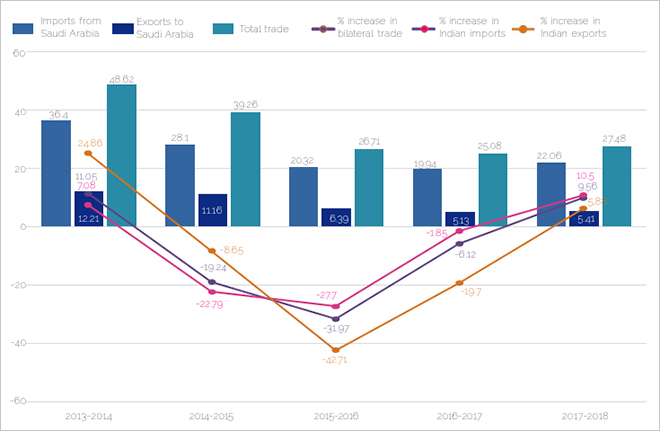 Source: Ministry of External Affair, https://mea.gov.in/Portal/ForeignRelation/India-Saudi_Bilateral_Relations_ December_2018.pdf
Source: Ministry of External Affair, https://mea.gov.in/Portal/ForeignRelation/India-Saudi_Bilateral_Relations_ December_2018.pdf
INDIA–UAE
During his first term, Prime Minister Modi made two visits to the UAE, showing the growing cooperation between the two countries. While trade remained the primary focus of those visits, shared security concerns with Abu
Figure 17: India-UAE Bilateral Trade (USD million)
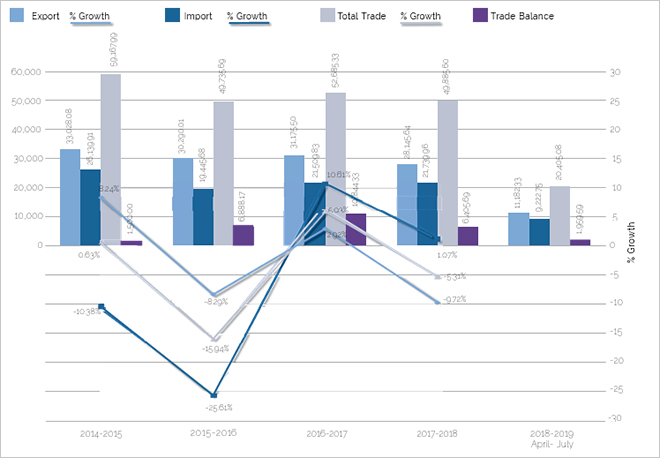 Source: Embassy website/MEA/Misc
Source: Embassy website/MEA/Misc
Dhabi also took centrestage. This cooperation extended to its big ally, Riyadh. In the earlier parts of this decade, a gainful counter-terror and intelligence- sharing cooperation between India and UAE would have been unheard of. Today, UAE often deports to New Delhi
<11> both terror suspects and those being prosecuted for financial crimes. On the economic front, the Gulf countries, predominantly UAE and Saudi Arabia, have in the past two years committed over US$52 billion to the Indian economy in areas such as infrastructure, oil refineries, and aviation. Figure 17 shows the bilateral trade between India and the UAE since 2014. Gulf cities like Dubai and Abu Dhabi have also become popular with Indian professionals in areas such as technology and business, representing a significant departure from the time when India was known only for providing blue-collar workers.
INDIA–ISRAEL
The Modi–Netanyahu friendship was seen as a ‘natural’ alliance even before Modi won the elections in 2014. The two leaders represented similar political and ideological approaches, and each saw parallels in the other, specifically as victims of terror. This led to the first Indian prime ministerial visit to Israel, which was preceded by Netanyahu’s visit to New Delhi. Between 2014 and
Figure 18: India-Israel Bilateral Trade
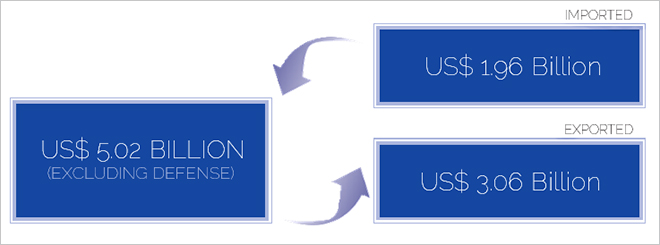 Source: Ministry of External Affairs, India
Source: Ministry of External Affairs, India
2018, India and Israel signed nine MoUs and conducted 25 high-level bilateral visits. Trade during the 2016–17 period stood at US$5 billion, excluding defence deals (See Figure 18). Both countries are also looking to commence talks on a Free Trade Agreement which is expected to propel bilateral trade over the US$10-billion mark in the short term—again this is expected to be led by the defence sector, which is reportedly already in the process of clearing US$13 billion worth of procurement deals. During this period, Air India also commenced direct flights between Tel Aviv and Delhi, overflying Saudi Arabia which does not recognise Israel as a state. This was seen as a significant achievement for all three parties, and highlighted as one of the cornerstone successes of India’s diplomacy approach in the region that is moving forward to ‘strategic autonomy’.
Overall, perhaps West Asia has been a major success story of Indian diplomacy in balancing competing regional interests. The fact that regional players in the region know that India is not a disruptor, but will engage with all at an equal, bilateral pedestal without overlap, helps New Delhi gain significant strategic hold with an increasingly significant economic heft. Modi’s visits to Israel, Iran, Saudi, UAE, and Oman (which often acts as “the Switzerland of the region” with its relatively neutral posture) helps maintain the required balancing act to conduct effective diplomacy in the region.
This article originally appeared in special report Looking Back looking Ahead.
<1> Sudha Ramachandran, “
India Doubles Down on Chabahar Gambit”,
The Diplomat, 14 January 2019.
<2> ET Online, “
PM Narendra Modi Awarded UAE’s Highest Civilian Honour Zayed Medal”,
The Economic Times, 4 April 2019.
<3> Sumantra Bose, “
Here’s Why Hindu Nationalists Aspire to Israel’s ‘Ethnic Democracy’”,
Quartz India, 15 February 2019.
<4> Kabir Taneja, “
India-Iran Ties: More Challenges than Opportunities”, ORF Commentaries, 19 February 2018.
<5> Elizabeth Roche, “
What Mohammed Bin Salman’s Visit has Done to Boost Saudi-India Ties”,
Livemint, 11 July 2019.
<6> PTI, “
Mahmoud Abbas Visits India: Narendra Modi Conveys ‘Unwavering Support’ To Palestinian Cause,”
Firstpost, 16 May 2017, .
<7> The Iran Nuclear Deal is officially known as the Joint Comprehensive Plan of Action (JCPOA).
<8> Mark Fitzpatrick, Michael Elleman and Paulina Izewicz, “
Uncertain future: The JCPOA and Iran’s Nuclear and missile programmes. IISS Report,” from its Diaspora,” 22 June 2018.
<9> Shreehari Paliath, "
India Remains World’s Top Recipient of Remittances From Its Diaspora", India Spend, June 22, 2018 .
<10> Jennifer Gnana, “
Adnoc and Aramco to Partner on $44Bn Indian Refinery”,
The National, 25 June 2018.
<11> Neeraj Chauhan, “
UAE Deports Five ISIS Suspects to India”,
The Times of India, 1 May 2019.
The views expressed above belong to the author(s). ORF research and analyses now available on Telegram! Click here to access our curated content — blogs, longforms and interviews.
 It may be seen as an anomaly that a government led by a Hindu-nationalist party, the Bharatiya Janata Party (BJP), would do well in its West Asia policy. Indeed, during Prime Minister Narendra Modi’s first term, New Delhi’s outreach to West Asia—with its multidimensional challenges, from security to religion—has arguably been one of the government’s biggest successes in foreign policymaking.
India maintained a ‘non-aligned’ presence in West Asia, balancing between the three poles of power—i.e. Israel, Iran and Saudi Arabia. At the same time, Modi’s outreach to strengthen these pre-existing but limited engagements has garnered immediate benefits, both in the security and economic arenas. Modi visited the capitals of all three power centres of Jews, Shia Muslims and Sunni Muslims alike, and his government reaped: terror suspects were deported from Saudi Arabia and the UAE; technological and defence partnerships were negotiated with Israel; and the Indian government came to the defence of India–Iran oil trade and the Chabahar investments amidst American pressure against Tehran.<1> While these three sub-regions have gained the most, other regional players such as Turkey, Oman, Qatar, Jordan—and even Syria and Palestine—also benefitted from the Modi government’s expansion of its regional outreach.
To be sure, the optics tended to score higher than the actual deliverables in many cases. Still, these engagements have managed to create a strong bedrock for greater cooperation specifically between India and the Gulf, long seen as a difficult relationship that largely revolves around the issues of oil and Indian migrant workers. There were many firsts during Modi’s tenure, including the first staging visit by an Indian Air Force flying contingent stopping over in Saudi Arabia, and Modi getting the highest civilian honour from the UAE, the Zayed Medal.<2> Over the past five years Modi visited all regional strongholds and areas of Indian interest: Riyadh, Tel Aviv, Abu Dhabi, Tehran and even Ramallah. In return, New Delhi hosted leaders Benjamin Netanyahu of Israel,<3> Hassan Rouhani of Iran,<4> Sheikh Mohammed bin Zayed of the UAE who was the chief guest at the Republic Day Parade in 2017, Saudi heir apparent Mohammed Bin Salman,<5> and Palestine’s leader Mahmoud Abbas.<6> These visits cut across regional tensions and conflicts to maintain not only working, but fast developing bilateral ties.
It may be seen as an anomaly that a government led by a Hindu-nationalist party, the Bharatiya Janata Party (BJP), would do well in its West Asia policy. Indeed, during Prime Minister Narendra Modi’s first term, New Delhi’s outreach to West Asia—with its multidimensional challenges, from security to religion—has arguably been one of the government’s biggest successes in foreign policymaking.
India maintained a ‘non-aligned’ presence in West Asia, balancing between the three poles of power—i.e. Israel, Iran and Saudi Arabia. At the same time, Modi’s outreach to strengthen these pre-existing but limited engagements has garnered immediate benefits, both in the security and economic arenas. Modi visited the capitals of all three power centres of Jews, Shia Muslims and Sunni Muslims alike, and his government reaped: terror suspects were deported from Saudi Arabia and the UAE; technological and defence partnerships were negotiated with Israel; and the Indian government came to the defence of India–Iran oil trade and the Chabahar investments amidst American pressure against Tehran.<1> While these three sub-regions have gained the most, other regional players such as Turkey, Oman, Qatar, Jordan—and even Syria and Palestine—also benefitted from the Modi government’s expansion of its regional outreach.
To be sure, the optics tended to score higher than the actual deliverables in many cases. Still, these engagements have managed to create a strong bedrock for greater cooperation specifically between India and the Gulf, long seen as a difficult relationship that largely revolves around the issues of oil and Indian migrant workers. There were many firsts during Modi’s tenure, including the first staging visit by an Indian Air Force flying contingent stopping over in Saudi Arabia, and Modi getting the highest civilian honour from the UAE, the Zayed Medal.<2> Over the past five years Modi visited all regional strongholds and areas of Indian interest: Riyadh, Tel Aviv, Abu Dhabi, Tehran and even Ramallah. In return, New Delhi hosted leaders Benjamin Netanyahu of Israel,<3> Hassan Rouhani of Iran,<4> Sheikh Mohammed bin Zayed of the UAE who was the chief guest at the Republic Day Parade in 2017, Saudi heir apparent Mohammed Bin Salman,<5> and Palestine’s leader Mahmoud Abbas.<6> These visits cut across regional tensions and conflicts to maintain not only working, but fast developing bilateral ties.
 Source: Ministry of External Affairs
Source: Ministry of External Affairs Source: Ministry of External Affair, https://mea.gov.in/Portal/ForeignRelation/India-Saudi_Bilateral_Relations_ December_2018.pdf
Source: Ministry of External Affair, https://mea.gov.in/Portal/ForeignRelation/India-Saudi_Bilateral_Relations_ December_2018.pdf Source: Embassy website/MEA/Misc
Source: Embassy website/MEA/Misc Source: Ministry of External Affairs, India
Source: Ministry of External Affairs, India 